




The first research paper I ever wrote was on ospreys. I was in the third grade, and my submission—written in pencil on wide-ruled paper—might have been two or three paragraphs long. I’m sure I was careful to use the very best penmanship I knew how.
Little did I dream that many years later, after moving to North Carolina, I would walk along a local stream and see an osprey land a few yards from me, clutching a fish in its talons. I was amazed.
In this issue, we bring you information about local ospreys, and how you can help local birds of all species by contributing your observations to global bird databases. We also learn how scientists are using new technology to learn more about migration habits. If recording your observations online isn’t your cup of tea, you can make a difference by taking a child out in nature—on a bird walk, or looking for native bees and other wildlife in your own backyard. We hope you’ll find ways to enjoy spending time outside this season.
A note about where to find copies of this magazine. Due to the pandemic, many of our 140 regular distribution locations became temporarily less available to walk-in traffic. Some of our long-time retail partners, listed below, continue to carry copies for their customers. We’ve supplemented our distribution of the print edition by renting space in racks found at 19 area Harris Teeter and Food Lion locations. We will be expanding our online map of locations over the coming weeks. And you can always read us online!
— Valerie L. Robertson EditorCape Fear’s Going Green is a quarterly publication promoting eco-friendly resources and lifestyles in the Lower Cape Fear River Basin.
Publisher & Editor in Chief: Valerie Robertson
Sister City: Eugene, Oregon (Voted “Greenest City” 2006 by The Green Guide)
Eugene Contributing Editor: Mary Robertson
Advisors & Editorial Contributors: Steve B, Carol Bales, Shelby Diehl, Morgan Freese, Amber Mallard, Sally Smits Matsen, Casey Nelson, Cordelia Norris, Avery Owen, Jill Peleuses, Shannon Bradburn Pragosa, Bryan Putnam, Jessica Scudella, Jack Spruill, Jessica Stitt, John Sutton, Christopher Tonra, Philip S. Wenz, Charley Winterbauer and Ally Zimmerman.
Cape Fear’s Going Green Going Green Publications P. O. Box 3164 • Wilmington, NC 28406 (910) 547-4390
publisher@goinggreenpublications.com www.goinggreenpublications.com
Editorial: If you have story ideas or calendar items to suggest, email us at editor@goinggreenpublications.com, or call (910) 547-4390.
Advertising information: Email ads@goinggreenpublications.com.
Cape Fear’s Going Green is distributed free throughout Brunswick, Columbus, New Hanover, Onslow and Pender counties. A partial map of locations appears at https://arcg.is/1WWi0y. If you have a business and would like to receive multiple copies for the public, please contact us. The views and opinions expressed in articles in this magazine are those of the authors and do not necessarily reflect the official position of this publication.
3
5
6
8
9
30
31
32
Front Cover: The Osprey (Pandion haliaetus), also called Fish Hawk or Sea Hawk, is one of this area’s most amazing raptors. The Osprey is very recognizable with its dark brown and white feathers, large claw like-talons and big yellow eyes. He is a large raptor with a body length of 24 inches or more and a 72-inch wing span. His diet consists mainly of all types of fish, so you will find his nesting areas near the water and marshes along our coast line. If you are out boating, look for the large nests built on the tops of channel markers and towers marking the waterway, rivers and inlets. Ospreys have a unique fishing technique. They hover briefly and then plunge feet first to catch the fish in its talons. After a successful strike, the bird rises from the water and flies away, carrying the fish head-forward with its feet. It was formerly classified with other hawks but now has been placed in a separate family of its own.
Photo by John Sutton.Read the most recent issues on issuu.com/capefearsgoinggreen.
Pick up a free copy at one of the locations listed below or at in-person meetings of environmental groups as they return to meeting live.
Arboretum/New Hanover County Extension Service, Aunt Kerry’s Pet Stop, Lovey’s Market, Old Books on Front Street, Pomegranate Books, Tidal Creek Co-op, UNCW, Shelton Herb Farm and many Food Lion and Harris Teeter locations. See https://arcg.is/1WWi0y for a map.
Subscribe
For the price of postage and packaging, you can receive the next four issues in your own mailbox. Mail a check payable to “Going Green Publications” in the amount of $16 to the address in the green box. Sign up for our email list to be alerted when each new issue becomes available. Write us at publisher@goinggreenpublications.com.
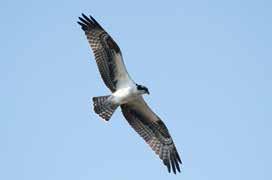
Ospreys are magnificent birds. Although they are found almost worldwide, they have become iconic in the lower Cape Fear region. Given many names— osprey, river hawk, sea hawk and fish hawk—our local university chose the name Seahawk for their mascot. A large sculpture of an osprey, or seahawk, by local sculptor Dumay Gorham is prominently displayed on campus.
Ospreys (Pandion haliaetus) are an ancient raptor. Fossil remains from 13 million years ago show they’ve changed little since then, indicating they they were so well suited to their environment that they haven’t needed to evolve.* They typically stay in our area for their nesting season, arriving in March and migrating south in August.
Captain Doug Springer has spent 15 years leading tours on the Cape Fear River, most recently on his custom-built motorized catamaran, the Wilmington. We asked him to share some of his observations about this iconic bird.
“I’ve spent a lot of time on the Northeast Cape Fear River,” said Springer. “That’s where I got really interested in watching the osprey. At one time, we had about 18 nests in about a five-mile stretch of the Northeast Cape Fear, north of here, going up towards Castle Hayne. The river has clear dark water—perfect habitat for osprey. We’ve been watching the changes, and we’re down to probably seven nests.
“We’ve seen increases and now decreases, and I’m always trying to find out what’s going on. We saw the biggest change after Hurricane Florence, when all the nests but two were destroyed. It hit when some of the babies were still on the nest.”
What usually happens is, the parents come back first. Typically, it wouldn’t be an issue if the nest weren’t there. They’ll spend about two weeks building a new nest and then they’re right back on track. But another inherent trait of the osprey is that the first year, once the young birds have found a mate and come back, they will practice building nests. They’ll build two or three practice nests, but won’t raise chicks because they come back almost too late in the season.
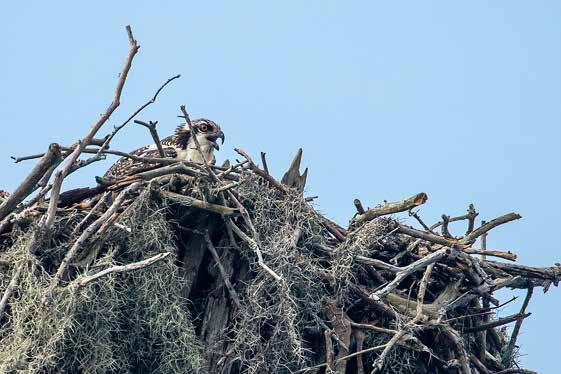
“After Florence,” Springer said, “when all the parents came back, they all started practice building nests again instead of rebuilding. They built on bridges, on power lines, all different places. Only two of the nests raised young that year, so there were two seasons without any young being raised here.”
Springer notes seeing an adaptation to the warmer river. It’s been warmer than it’s ever been in recorded history.
Typically, the parents migrate away first. They depart at the end of August, leaving the young birds here. The young birds stay
until they’re absolutely forced to leave, and what makes them leave is when the water turns cold, the fish go deep to stay warm and the birds’ food supply goes away.
Now that the river is warmer, the fish are available later in the season and so the birds try to stay here. We don’t fully know what the impact of this is. A small percentage make it through; others aren’t here at the end of the winter.
Ten years ago, the ospreys nested in the dead cypress, but those trees aren’t going to be there forever. Springer suggests we start scientifically putting platforms up in this colony of birds to see how receptive they are, since ospreys often nest on telephone poles, duck blinds and other types of manmade structures. Area property owners he’s spoken with are more than willing to have osprey platforms built on their property.
(continued on page 4)
“I’d like to get the university involved, map out a program, and get artists in this community to design creative-looking platforms,” said Springer. “That would draw people up there who are interested in artwork as well as those wanting to see the birds. We could light it in the winter months, [when the osprey are away], as a draw to get people up into those areas.”
The osprey population has plummeted on the Northeast Cape Fear River over the last four years. People tell Springer they’re seeing a difference in migration patterns as well. A lot of the birds now stop in Florida instead of continuing on into Cuba and South America.
On his boat tours, Springer talks with people about global warming, explaining his “take” on climate change.
“Mother Nature inherently recognizes change, whether it’s a cypress tree that sees the water getting fresher and tries to grow again, or an osprey modifying its migration
period. Our alligator season is five weeks longer than it was ten years ago. Alligators love global warming. I’m convinced they’re going to start building power plants. They love it. But I say Mother Nature inherently recognizes change and then her instinct is to do something different. It may work or it may not. But she’s going to try to do different things.
“Our job as humans is to recognize change but also to recognize when change gets out of sync. We’re no longer seeing a nice sine wave of change. The world heats up and cools down, but it doesn’t happen exponentially unless something unusual (like a meteor strike) happens.
“When we see the world heating up quickly, we can try to learn the cause. If we can keep change in some sort of sine wave, we can try different things to adapt, and our chances of adapting will be so much better. If global warming scares you, which I understand, at least don’t deny yourself the opportunity to recognize the change around you, because it’s interesting.”
For people who haven’t really thought about the ospreys around here, they are very much a part of us. If you want to start looking for change, and understand change, Springer suggests you find an osprey nest. Watch it, and write down when the birds return in the spring—likely about eight days before St. Patrick’s Day. Note the change you see, and put it on a calendar. When did they fledge the young birds out of the nest? How many fledglings were there? Did the fledglings stay here or did they leave? How long has it been since you last saw that young bird?
Get to know the birds. Name them. Have fun with it. See whether you can notice when they come back in the spring.
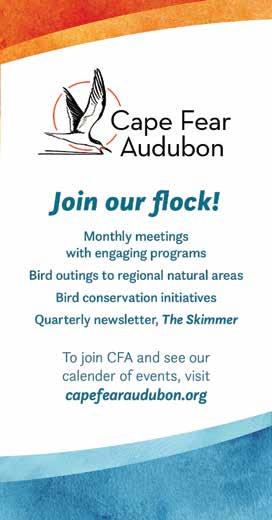
In addition to changes in osprey behavior, we are seeing the local alligator season being extended. Alligators used to go into hibernation when football season hit. Now, it’s about three weeks after. They also emerge earlier in the spring. The magic temperature for alligators is 70 degrees— that’s when they come out into the river. We are seeing more alligators in North Carolina than before.
If you aren’t following an osprey or alligator, observe a songbird in your backyard. Start taking notes on when you see that bird nesting, and note whether it’s different the following year. Count how many chicks they have. You might see the bird’s coloration changing. Anything you do look at is changing—there’s nothing that’s not.

Springer dreams of creating a Walden’s Pond type of experience on the river. He’d like to put a houseboat on the NE Cape Fear River and arrange for a couple of students to live there for a season to observe the ospreys and anything else they’d like to observe.
He does find that adults are becoming more receptive about hearing about global warming. “They’re hearing their kids talk about it, over and over, so it’s harder for them to assume the ostrich position. Let’s not be ostriches, let’s be ospreys. Let’s recognize change.”
If you’d like to go out on the river with Doug Springer, Wilmington Water Tours cruises on the Cape Fear River will resume on March 12, 2022. Learn more at https://wilmingtonwatertours.net.
See how climate change will reshape the range of the osprey, at https://www.audubon.org/field-guide/bird/osprey.
Winter is an excellent time to birdwatch because once the leaves fall off many trees, it’s easier to see birds among their branches. For that reason, specified dates for bird counts tend to be in the winter.
The Cape Fear region, considered a biodiversity hot spot, has a wonderful diversity of birds. Whether you’re new to birding or new to the area, here are some options for getting started.
Watch for birds in your own backyard. If you look for birds a few minutes each day, you’ll discover who are your regular visitors and who are newcomers
throughout the year. Participate in eBird or FeederWatch to record your list of birds seen. If you enter your observations on eBird, it will automatically generate your personal “life list,” or list of all birds you’ve ever seen.
Go on a bird hike. Airlie Gardens and Halyburton Park both offer monthly gently-paced guided bird hikes that welcome newcomers. Veteran birders are eager to share information, so this can be a fun way to learn and hone your powers of observation. Serious hikers might enjoy monthly
(continued on page 7)
Jill Peleuses, owner of Wild Bird & Garden, offers tips on how anyone can prepare to participate in a bird count.


Birding to help citizen science is a great idea, but how does one get started? There are a variety of great organized bird counts in which individuals can participate. The Christmas Bird Count, Project FeederWatch, Great Backyard Bird Count and eBird.org are all bird counts that utilize citizen scientists’ reports to help get a database of bird activity in different regions across the country. The first three of these happen at specific times of the year; eBird observations can be recorded whenever you see birds throughout the year.
To join an organized bird count, there are some good ways to prepare. Join a local bird walk to become familiar with birds in your area during the season of your count. Bird watch with friends and those in your community, writing down the birds you spot and checking your bird book to familiarize yourself with unfamiliar species.
Getting to know the birds in an area will help you be a better citizen science reporter. Learn how to find birds in the field. Watch for movement, scanning the trees and shrubs for shapes that are out

of the ordinary. Watch for birds flying and notice where they land. This can help hone in on a bird with your binoculars. Feel comfortable pointing out birds to other birders that may have a higher level of identification skills. Even if you do not know a species, you can help a group count by telling experienced birders where you see a bird, so they can identify it.
Another thing that can be helpful when joining a count is to be prepared. Dress in layers. The bird count may start in the early morning when you need warmer clothing and end in the afternoon when the temperature difference requires shedding layers. Bring a snack, water bottle and hat, and wear sunscreen. Bring binoculars; most birders like 8x42 pairs. This size provides close range, good distance and lots of incoming light, which is key to seeing small features on a bird. Choose binoculars that are waterproof so that they can handle all weather conditions. Try on binoculars before buying them to make sure they are a good fit for your eyes and feel comfortable in your hands. Bring a bird book to help identify the species on your bird count, making sure it’s updated with current species and range maps. Most of all, have fun and enjoy bird watching while contributing to science.
A listing of bird counts and links to information on how to participate appear on page 7.
Green Wall – continued
The Cape Fear Bird Observatory (CFBO) is a new 501(c)(3) that focuses on the biology, ecology and conservation of birds. The CFBO’s mission is to strive to promote the conservation of birds and their habitats in North Carolina through research, education, outreach and community involvement. Founded by a group of passionate women with years of experience in avian ecology in North Carolina, the Cape Fear Bird Observatory is sure to become a fixture in the local science and education community.

The Cape Fear Bird Observatory is starting strong with four ventures:
1. Color banding Painted Buntings in southeastern North Carolina. This allows members of the community to identify uniquely marked individuals which easily connects communities with these vibrantly-colored, charismatic birds.
2. Establishing a migration banding station at Carolina Beach State Park. Migration monitoring provides insight into seasonal movement and timing of migration as well as habitat use in the area.
Each plant in the wall lives in its original pot, which is
directly in its tray. The plants will grow towards the light, so

from the City of Wilmington Tree Commission for Outstanding Function Design at the New Hanover Regional Medical Center Betty Cameron Women’s and Children’s Center (a rooftop garden that can be visited by patients and their families).
Welcome Service LLC personally welcomes newcomers and new businesses to New Hanover, Brunswick and Pender Counties.

What was it about this project that pulled Mott out of retirement for what was obviously going to involve a lot of time and effort?
Call Nancy Wilcox at 910-470-0286 nkwilcox58@gmail.com www.welcomeservicesllc.com
For one thing, the sheer complexity of the project was enticing. It was new and different and challenging. “I had to learn an awful lot. I mean I’d done this kind of work forever, but still this is a new system I haven’t used... Also just the logistics of it, you know. Building something inside here is like building a ship in a bottle. It was complex enough to be interesting.”
After over a year of staying isolated we are happy to get back to doing plant walks. We look forward to going to new places and are open to your suggestions.
Even more important, though, this project was an opportunity for him to prove that such a complicated project could be very successful. And he was concerned that if a green wall were attempted but were not a success, that might be the end of using green wall technology in Wilmington. But he was confident he could make it work. “If it’s successful and it gets some of the notoriety I think it’s going to get, you’ll see a lot of them, maybe not this big. This is a major undertaking in anybody’s book.” He believes that the success of his green wall will encourage others.
If you would like to be informed on the walk schedule and other plant-related activities, go to www.ncwildflower.org and join the state-wide NC Native Plant Society. Based on your address, you will automatically be assigned to a local chapter. For the SE portion of the state, that is the SE coastal area chapter.

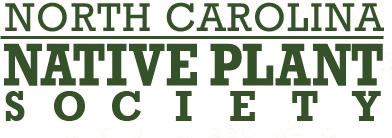
Mott plans to put together information on the newly completed green wall, enough so that people will have documentation on how it was created. What he’d really like is to put together a class to teach what he’s learned to people who are eager to learn.
Who will get to visit the wall every day? As floors of the building are finished, the building will be rented out as office
Questions? Email cewinterbauer39@gmail.com.
3. Creating Wilmington Youth Birding, a program focused on the community’s youth that will work to engage elementary and middle-schoolaged kids through in-school nature walks and activities.
space. One of the tenants will be the Wilmington-based software company Untappd, creator of the popular beer app.
It’s Mott’s hope that, through the success of this green wall, they will grow in popularity in our area. And that way, more building occupants will enjoy the health and aesthetic benefits of systems like these in the near future.
Although Steve Mott has once again proclaimed himself to be retired, you may be able to reach him through his website, www. mottlandscaping.com.
4. The CFBO is the new home of hummingbird research in North Carolina. This long-term endeavor— started by Susan Campbell in 1999—will now be operated through the observatory. The move
will allow for greater visibility of the various aspects of this endeavor. As a result, the scope of Campbell’s research should broaden significantly with increased support.
Birds are indicators of environmental health and their ubiquity makes them accessible to people of all levels of interest and skill. Monitoring them with community assistance allows the Cape Fear Bird Observatory to positively impact the local environment. Donations to this non-profit directly support local avian research. Go to capefearbirdobservatory.org for more information.
Cape Fear Audubon (CFA) is offering an Educator Scholarship to attend “Sharing Nature: An Educator’s Week” from July 17–22, 2022 at Hog Island in Bremen, Maine. CFA will award one $2,000 scholarship to an eligible elementary school science teacher in Brunswick, New Hanover, Onslow or Pender County who is passionate about teaching science. The $2,000 award will be divided as follows: $1,590.00 will be paid to Hog Island to cover standard shared room and board as well as other session costs. A check for the remaining value will be issued and may be used to help defray travel costs. See https://capefearaudubon.org and click on the “scholarship” button for scholarship details. Learn more about the Hog Island Audubon Camp at https://bit.ly/3BVolia.
A scissor lift was used to allow placement of the plants. The lift only reached 22 feet, so Mott had to place a ladder on top of the platform shown at the top of this photo, in order to reach the last several feet of wall.
Completed applications should be emailed to Educational Coordinator Catherine Nesbit at Cnesbit716@gmail.com and received by March 7, 2022. Please contact her at that address with any questions. The scholarship awardee will be notified by March 15.
hikes along the NC Birding Trail, usually two miles. The Trail is not a physical hiking trail like the Appalachian Trail, rather, it’s a collection of noteworthy birding locations all over the state. They represent the variety of habitats that exist in North Carolina, from coastal estuaries to longleaf pine savannahs to spruce fir forests. Upcoming hikes: Ev-henwood Nature Preserve, March 17; Holly Shelter Gamelands, April 21. Learn more at https://www.ncbirdingtrail.org/ what-is-the-nc-birding-trail/.
Join a group or attend a lecture. Cape Fear Audubon offers monthly programs with engaging speakers who typically show beautiful slides. This winter, due to the pandemic, programs are held on Zoom (instead of in person at Halyburton Park), and recordings of recent programs may be available online on request. Some sample recordings are:
Impacts of Sea Level Rise on Saltmarsh and Seaside Sparrows, by Marae Lindquist West, November 2021
Video
from page 5)
https://bit.ly/36a4fopAccess
Passcode: M@rshSp4rrow
Winter Birds and Christmas Bird Count, by Jill Peleuses, December 2021
https://bit.ly/3uSTcdF
Passcode: J!llWinter2021
Join an online group. There are several on Facebook, each with a different focus, whether you wish to compare notes with other birders or post your own bird photos. Participate in a bird count. These timelimited bird counts are annual events, so practice your birding skills and remember to look for these events at roughly the same time each year. Here are 2022 dates as a guideline:
122nd Audubon Christmas Bird Count December 14–January 5, 2022
This takes place in individual count circles; locally, one day each in Southport, Wilmington, Holly Shelter and Camp Lejeune. https://www.audubon.org/conservation/ science/christmas-bird-count
Jill Peleuses’ “Backyard Birdwatching” video on YouTube has good recommendations for beginners. See https://bit.ly/3sLCiLg.
Books
Nate Swick, The Beginner’s Guide to Birding: The Easiest Way for Anyone to Explore the Incredible World of Birds
Nate Swick, Field Guide to Birds of the Carolinas (photos: Brian E. Small).
Stan Tekiela, Birds of the Carolinas Field Guide
David Allen Sibley, Sibley Birds East, The Sibley Field Guide to Birds of Eastern North America: Second Edition
Cordelia Norris, Suzanne Matheson, & Joseph Cadotte, Hatchlings: A Coloring Book Anthology
Tips for learning to identify birds by their song
From All About Birds: https://www.allaboutbirds.org/news/ how-to-learn-bird-songs-and-calls/
From Cornell Lab of Ornithology: Bird Song Hero: The song learning game for everyone https://www.youtube.com/watch?app=desktop&v=8xH2GjHKYj0
Fundraiser Bird Walk to Benefit CFBO March 18
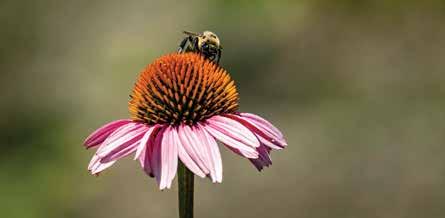
Join Island Wildlife–Cape Fear Region and Jill Peleuses of Wild Bird & Garden for a March 18 bird walk to benefit the new Cape Fear Bird Observatory. Participants willl meet at 8 a.m. at Greenfield Lake Park by the paddleboats. Learn more at https:// bit.ly/3HRz2Es.
Great Backyard Bird Count:
February 18–21, 2022
https://www.birdcount.org/participate/
Project Feeder Watch:
November 13, 2021–April 30, 2022 (pick your own dates within that range)
https://feederwatch.org/about/ how-to-participate/
NC Bird Atlas:
November 1–December 31, 2022 (year 2 of 5)
https://ebird.org/atlasnc/about/atlasessentials eBird: www.eBird.org
October Big Day
October 8, 2022
https://ebird.org/atlasnc/about/ atlas-essentials
eBird: All year
https://ebird.org/home
You can use eBird to record birds you observe anywhere, any time. It also acts as the recording tool for some of the bird counts listed above.
birds
The Motus Wildlife Tracking System (Motus) is a program of Birds Canada, in partnership with collaborating researchers and organizations, that uses automated radio telemetry to conduct research and education on the ecology and conservation of migratory animals. Currently, there are more than 400 Motus stations globally that have made over 200 million detections from greater than 6000 individuals of 76 species tagged. Dr. Christopher Tonra, associate professor of Avian Wildlife Ecology at Ohio State who is familiar with the program, presented it to Cape Fear Audubon in October 2021.

To use the program, researchers attach a tag to a bird that transmits a unique signal that makes each tag identifiable by its frequency. These signals are detected by automated telemetry towers, towers that use receivers to detect frequencies from the bird tags. The average tag has a life-span of seven months, which means that if researchers tag a bird during spring migration, if the bird returns during fall migration, they can detect it.
In using tags, researchers seek to answer questions such as how these birds are using space, what habitats they can be found in and how much time the birds are spending at stopover sites. Tags can also answer basic migratory behaviors such as what routes the birds are taking through the region. With this method, researchers have also found lots of movement among migratory birds, including commuting behaviors between foraging and roosting locations.
Motus can be accessed by two different setups: the first is Lotek, an expensive option that provides direct access to data, but without internet access; the second is Sensorgnome, an affordable option that doesn’t allow direct access to data, but has internet capabilities.
Dr. Tonra focused on his Motus research in Lake Erie—the shallowest of the
Great Lakes. Lake Erie is a major migratory corridor, especially the western basin, since the area has some of the last remaining remnants of the Great Black Swamp which, after the Everglades, was once the largest contiguous wetland in North America. The stopover habitats are attractive to migratory birds and therefore draw large numbers of migratory birds.
In the data, when birds are detected by two towers, timestamps record the exact time the bird left the vicinity of one tower and passed by another. While detections have been made by other towers around Lake Erie, there have been detections by towers erected and monitored by other organizations in Cape Romain National Wildlife, South Carolina; Refuge Key Island, Florida; and in the Caribbean. This data is found due to the communication, collaboration and sharing of data from researchers across the Motus network, a feature provided by Motus.
These measurements have allowed researchers to study the bird’s migration speed. With these timestamps, Dr. Tonra found migratory birds are much more likely to depart when they have a strong tailwind behind them because it saves energy. There is a difference between males and females, too. The data found that males have a higher probability of surviving the post-fledging period than females.
Cape Fear Audubon, with assistance from the Danner Lab at the University of North Carolina at Wilmington, is spearheading the placement of a Motus tower at Lea-Hutaff Island, an undeveloped barrier island in Pender County. Simultaneously, the North Carolina National Estuarine Research Reserve (NC NERR) is funding the placement of a Motus tower on Masonboro Island, an undeveloped barrier island in New Hanover County.
“[The Lea-Hutaff] tower will be important for tracking migratory species that pass through our area or may use LeaHutaff as a stopover site during migration,” said Marae Lindquist, a Ph.D. candidate
(continued on page 9)
Photo courtesy of Dr. Christopher Tonra Christy Stein and Jay Wright set up a pair of automated telemetry towers.David Gessner is an American essayist, memoirist, nature writer, editor and cartoonist. He was born in Boston, Massachusetts and grew up in Worcester, Massachusetts. With time, Gessner found his way to Wilmington, North Carolina. He now serves as Chair of the Creative Writing Department at the University of North Carolina Wilmington, where he is also the founder and Editor-in-Chief of the prizewinning literary magazine, Ecotone.
When David Gessner returned to Cape Cod, a place he spent his summers at in his youth, he noticed something he had never seen before: hawks with magnificent six-foot wingspans and dark masks.
Motus (continued)
working in the Danner Lab. “The information collected from this Motus tower will help the researchers who tagged the birds that fly over the tower and help our local organizations understand what birds are using our area during migration.”
While there are no plans to tag birds at the Lea-Hutaff tower, the Masonboro tower will be tracking Seaside, Saltmarsh and Nelson’s Sparrows. (All bird-banding and radio-tagging is performed under state and federal permits.) The Lea-Hutaff installation will be an important resource to help determine the migratory timing for the species tagged on Masonboro Island as well as to educate the public on these migratory birds.

“Understanding the ecology and movements of migratory birds is an essential function of conserving them,” Lindquist said, “so ideally this tower will help foster an understanding of the migratory birds that pass through our beautiful region.”
Shelby Diehl is a junior at the University of North Carolina at Wilmington studying environmental science with a concentration in conservation and creative writing with a
Gessner’s Return of the Osprey: A Season of Flight and Wonder is an immersion into the lives of these extraordinary birds. Over the full course of a nesting season, Gessner observes ospreys’ remarkable adaptability, astonishing fish-catching skills, housekeeping habits, and, when the chicks are born, both their savage and gentle ways of nurturing. And he witnesses an extraordinary event: the survival of ten young ospreys, the most his Cape Cod neighborhood has seen in more than half a century.
Return of the Osprey is a story of a remarkable recovery, a celebration of place, and a thoughtful meditation on finding one’s way in the world. In the process, he takes us on a journey into the wild and the tame, the beautiful and the fragile.
“…A reader could put “Return of the Osprey” aside at this point and feel the satisfaction that comes at the end of a memorable book. But Gessner has only been waiting for his chance for him, and the ospreys, to dazzle. And when it comes, Gessner puts you right there.”
—The Boston Globe
This story has been commemorated in the nature writing community, and has sparked more conversations about osprey and the conservation of their species. With praise from the likes of The Boston Globe and Rocky Mountain News, this story is a must read for anyone with a love for birds.
certificate in publishing. She is a Going Green intern and plans to pursue a career in environ-
mental writing that will allow her to advocate for environmental causes worldwide.
Photo courtesy of Dr. Christopher Tonra The yellow dots depict towers and each bubble represents a 15-kilometer-long detection area. Information collected in these bubbles is transferred to the Motus network where information is available to various researchers across the towers.Sturgeon City Environmental Education Center located in Jacksonville, North Carolina started as a community project to clean up Wilson Bay. The Center, just a short walk away from Wilson Bay, is the site of the former Wilson Bay Wastewater Treatment Plant that operated until the late 1990s. Wilson Bay is on the New River and became closed to the public when high levels of bacteria and pollution were discovered.
Jacksonville, a constantly growing city, became too much for the treatment plant to keep up with. Once the Wastewater Treatment Plant was decommissioned in 1998, a massive volunteer effort to clean up the bay resulted in a revitalized body of

water as well as a community that wanted to carry on this lesson of environmental stewardship and civic involvement. The former wastewater treatment plant was not demolished, but served as a reminder of what had been. This enormous cleanup effort was the result of the City of Jacksonville’s sense of moral responsibility to clean up Wilson Bay and the New River after years of pollution from the Wilson Bay Wastewater Treatment Plant.
The City of Jacksonville Stormwater staff planted 10 square acres of wetlands and, with the help of students and other volunteers, they landscaped Sturgeon City Park. This amounted to approximately 100,000 plants and took about a year and a half to complete. The current Stormwater
Manager, Pat Donovan-Brandenburg, has been working on the Oyster Highway project from the beginning. Pat explained how it was necessary to clean up the trash and debris before planting and restoring the area.
The Oyster Highway was created to clean up the pollution. Armed with volunteers, oyster reefs were placed from Wilson Bay to Stone Bay, along the New River, to increase oxygen levels in the water. Bioremediation was used to clean the bacteria from the water with oysters as they serve as a natural filtration system. These efforts allowed the New River to reopen to the public in 2001. Now there are boardwalks and trails throughout Sturgeon City Park.
The Sturgeon City nonprofit was founded in 2001 to continue the promotion of environmental and conservation efforts that were brought about with the Wilson Bay Water Quality Initiative. Their mission is “to become the model for inspiring youth leadership, civic involvement, habitat restoration, environmental education and stewardship of the New River and coastal wetlands.” It was here that students had outside-of-school opportunities to learn hands-on about science. The Sturgeon City Institutes, a high school science program, has recurred every summer since the nonprofit was founded. Here students can immerse themselves in a week of science or marine biology lessons and learn more about the history of Sturgeon City.
(continued on page 11)
Oysters do an amazingly effective job of filtering and cleaning our waterways, and healthy oyster reefs serve to help rebuild our coastline. Organizations such as the North Carolina Coastal Federation (NCCF) and the N.C. Division of Marine Fisheries recycle oyster shells and use them to build oyster reefs and to create living shorelines, which help abate soil erosion.
Oysters are so valuable in this role, that it is illegal to throw them away. Recycling drop-offs are available for consumers to recycle their discarded shells. The NCCF accepts oyster shells at or near its three offices in coastal North Carolina. Visit https:// www.nccoast.org/project/oyster-shellrecycling-program/ for a list and a map of locations in Brunswick, Dare, New Hanover, Onslow, Orange and Pender counties.
NCCF is partnering with Brunswick County’s Solid Waste and Recycling Program to expand its recycling locations in Brunswick County. The four newest drop-offs are located at:
• Leland, 9921 Chappell Loop Rd.
• Southport, 8392 River Rd.
• Sunset Beach, 736 Seas Rd.
• Supply, 1709 Oxpen Rd.
Photo courtesy of City of Jacksonville Media Services A view of Wilson Bay and some of the former Wilson Bay Wastewater Treatment Plant.In 2019, Sturgeon City expanded into its Environmental Education Center. This 11,000-square-foot building allowed the nonprofit to broaden what they could offer the community. The space is used for many programs including, but not limited, to Teen Science Café, Little Learners, Homeschool Science, and School’s Out. They host a variety of public events, such as their Earth Day Celebration. The building is also a rental space that allows for community use.
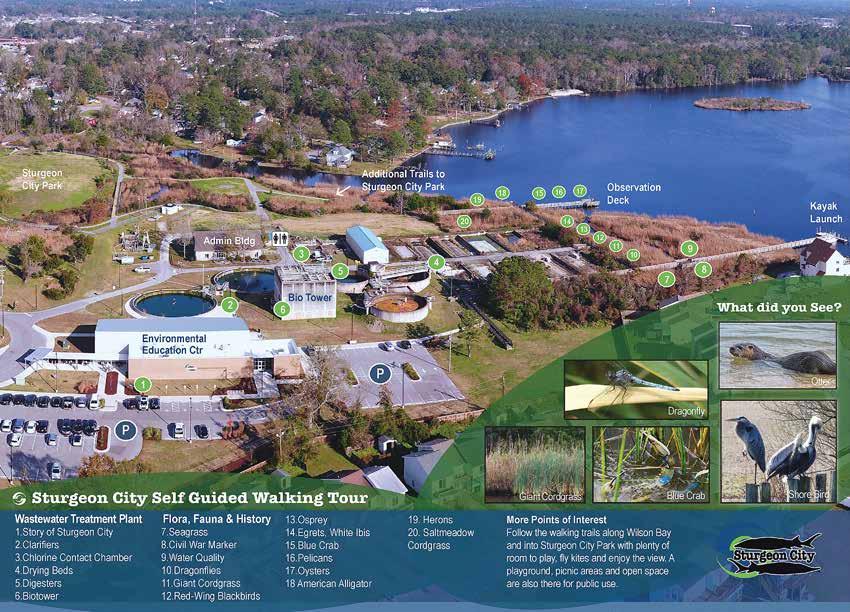
Sturgeon City, named after a prehistoric fish that once thrived in
the Wilson Bay and New River, was extirpated after many years of pollution in the water. The hope is that one day the fish will return to the clean bay and river.
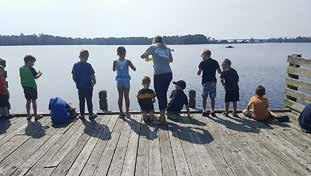
Sturgeon City has volunteer opportunities from ages 16 and up. To learn more about Sturgeon City Environmental Education Center, please visit their website: www.sturgeoncity.org/.
Jessica Scudella is a senior pursuing degrees in environmental science and political science at UNCW. Before serving as an intern with Cape Fear’s Going Green, she served as an intern at Sturgeon City Environmental Education Center. She now works there parttime as an Educator.
Photo provided by Sturgeon City Environmental Education Center An aerial view of the former Wilson Bay Wastewater Treatment Plant. Sturgeon City has a self-guided walking tour with signs throughout to teach residents about the ecosystem. Photo by Amber Mallard Wilson Bay has a large population of Blue Crab that visitors can try to catch. This group is using a pool noodle with a string attached to a piece of chicken to catch them.The second Tuesday of every month. Come join us 6–8 p.m. at Old Books on Front Street • 249 No. Front Street • Wilmington
Now in its eleventh year, the Environmental Book Club is organized by Cape Fear’s Going Green and hosted by Old Books on Front Street. Our Book Club meets the second Tuesday evening of the month inside Old Books on Front Street. Social time is at 5:30, discussion begins at 6:00 and runs approximately two hours. The bookstore closes at 8:00 p.m. There’s no longterm commitment: you can come when the book being discussed is a title that interests you! (We do hope you’ll read the book before you come, as it enriches the conversation.)
We will continue offering a hybrid Zoom + in-person gathering while the pandemic continues. The first ten people to RSVP can attend in person if they wish. (We wear masks and sit in a VERY large, socially-distanced circle.) Anyone wishing
to join via Zoom is invited to do so: RSVP and we’ll send you the meeting log-in details. RSVP by email to Valerie_L_Robertson@msn.com or call (910) 547-4390.
Sign up for the Going Green newsletter, and let us know if you’d also like to be on the email list for Environmental Book Club news. Email Publisher@GoingGreenPublications. com or sign up directly on our website: GoingGreenPublications.com. Questions about Book Club? Call (910) 547-4390
Old Books on Front Street offers a discount on new copies of our Book Club selections (and to anyone arriving by bicycle). Call ahead to make sure they have your book in stock: (910) 762-6657.
NOTE: Any changes to schedule (whether for weather or any other reason) will also be posted on our online calendar, so please check the day of the event to make sure. Just go to the online calendar at www. GoingGreenPublications. com and click on the meeting date to pull up details. Or call us, at (910) 547-4390.
Sign up for the Environmental Book Club mailing list, and we’ll share details about this year’s books as well as tips for accessing them as audiobooks or eBooks through New Hanover County Public Library, using Hoopla or Libby.
We invite you to follow us on social media:
• Instagram @capefearsgoinggreen
• Facebook @Cape Fear’s Going Green
Please remember to RSVP if you’d like to attend our meetings. Until the pandemic subsides, we have a ceiling of how many people can attend in person. Also, there may be times we have to change the meeting location last-minute due to construction being done on Front Street outside the book store where we usually meet.
January 11
All We Can Save: Truth, Courage, and Solutions for the Climate Crisis

Editors: Ayana Elizabeth Johnson and Katharine K. Wilkinson
February 8 (two books)
On Tyranny: Twenty Lessons from the Twentieth Century
Timothy Snyder and also:
Founding Gardeners: The Revolutionary Garden, Nature, and the Shaping of the American Nation
Andrea Wulf
March 8
All the Wild That Remains: Edward Abbey, Wallace Stegner, and the American West
David Gessner
April 12 (two books)
A Field Guide to Climate Anxiety: How to Keep Your Cool on a Warming Planet
Sarah Jaquette Ray and also:
Is it Really Green? Everyday Eco Dilemmas
Answered
Georgina Wilson-Powell
May 10
Finding the Mother Tree: Discovering the Wisdom of the Forest

Suzanne Simard
June 14
The Death and Life of the Great Lakes
Dan Egan
July 12
The Unsettling of America: Culture & Agriculture
Wendell Berry
August 9
A World on the Wing: The Global Odyssey of Migratory Birds

Scott Weidensaul
September 13
Untamed: The Wildest Woman in America and the Fight for Cumberland Island
Will Harlan
October 11
Beyond the Hundredth Meridian: John Wesley Powell and the Second Opening of the West
Wallace Stegner
November 8
Walkable City: How Downtown Can Save America, One Step at a Time
Jeff Speck
December 13
The Nature Fix: Why Nature Makes us Happier, Healthier, and More Creative
Florence Williams
January 10, 2023
The Journeys of Trees: A Story about Forests, People, and the Future
Zach St. George
We hear more and more about restaurants adding vegan options to their menus due to the growing popularity of eating plant-based food. If you’re not familiar with vegan dining, what is it like to eat in a restaurant that serves only vegan food? If you go, is there a chance nothing on the menu will appeal to you? Will you have to eat lettuce or hummus?
If you are vegan, or are trying to follow a plant-based diet, until recently the only way to be sure the food on your plate was strictly plant-based was to prepare it yourself at home. A typical restaurant can feel like a minefield. Were these vegetables cooked in butter? Were they grilled alongside my neighbor’s hamburger? Was the “vegetarian” soup made using chicken broth? Will they get annoyed if I ask questions about how the food is prepared?
If you do prefer vegan food, or would like to try it, you’re in luck. Wilmington now has three restaurants that offer only plantbased dishes. We decided to try them all, and let you know about our experience.
Our conclusion? We found that choosing to go to a vegan restaurant is no different than choosing an Indian restaurant,
or Italian restaurant, or one that serves primarily French cuisine. Even if you consider yourself an omnivore, the quality of the food at these all-vegan restaurants will have you coming back. We found the staff to be helpful, accommodating and eager to answer all questions. Here are our impressions of the three.
Sealevel City Vegan Diner’s hot pink exterior is hard to miss. The light, bright interior is decorated with a selection of vintage pieces, local artists and eccentric furnishings. Sealevel welcomes guests to experience the vegan dining experience in a casual, leisurely atmosphere. From tabletops to booths to floor seating, there are seating options for everyone.
The menu is very eco-conscious, reminding guests that all items are vegan, and that a majority can be made glutenfree. The menu contains appetizers, dogs, sandwiches, burgers and more. Restaurant staff are constantly whipping up new specials, such as their renowned shrimp burger. There is a delicious selection of beverages as well, including teas, lemonades, mimosas and more.
Sealevel’s carry-out containers can be composted in an industrial facility such as the in-line composter at the New Hanover County recycling center. There’s a bin outside the restaurant for customers to return their compostable carry-out containers after use. The menu even encourages bringing your own reusable containers, whether ordering carry-out or making sure your leftovers don’t go to waste.
This casual dining experience offers many food options developed in their kitchen. Sealevel City Vegan Diner is an inexpensive, easy choice for a lunch or dinner stop. The charming staff and laid-back atmosphere create a good introduction to vegan dining for first-timers and returning guests. Don’t forget to check out their flamingo- and cow-themed bathrooms!
Sealevel City Vegan Diner is open from 11 a.m.–9 p.m. Tuesday through Sunday. The restaurant’s address is 1015 S. Kerr Ave., Wilmington, NC. You can find them on Instagram at @sealevelcitydiner. Visit www.
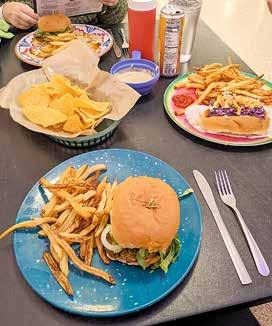
facebook.com/SealevelCityDiner/ for more information.
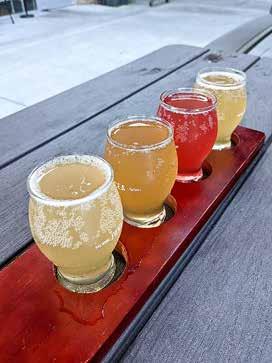
What started off as a vintage van, now called the “Boochbus,” has become a bustling restaurant serving as Wilmington’s go-to kombucha spot. The fanciful murals and eclectic decor create the sense of a whimsical, laid-back pub. This atmosphere provides a chill environment to dine on unique dishes. With weekly live music multiple days a week, Panacea Brewing Co. is the perfect place to relax with friends.
With a mix of alcoholic and non-alcoholic options, Panacea provides you with both seasonal and year-round drinks bound to keep you coming back for the rotation of flavors. You’re not limited to just one though—you can order flights with four different flavors to sample a wide variety, a great choice for the indecisive. The food menu pulls in southern fare and tavern type food, serving dishes like pimento cheese plates, cauliflower wings, BBQ pork tacos and veggie burgers galore.
Keep an eye out for the Boochbus—a 1975 Volkswagen Westfalia—at different farmers’ markets throughout the Cape Fear Region. One of Panacea’s sustainable (continued on page 14)
Vegan Dining (continued from page 14) practices is their reusable growlers, which can be refilled with either kombucha or beer. After you buy your first growler, the beverage prices are cheaper when you use your reusable container.
If you’re looking for a casual dining experience on the more affordable side. Panacea is a great destination for all lovers of food—the vegan/vegetarian fanatics and those wanting to try plant-based food for the first time.

Panacea Brewing Co. is open from 11 a.m.–9 p.m. Wednesday through Sunday. The restaurant’s address is 4107 Oleander Dr. Unit H, Wilmington, NC. You can find them on Instagram at @panaceabrewingcompany. Visit www.panaceabrewingcompany.com for more information.
The Green House
Elegant yet casual, The Green House sets an immaculate tone for the fine dining experience. The interior is beautiful with its clean lines and modern white upholstered chairs. It has the elegant feel of a “white linen tablecloth” restaurant but without
the tablecloths; instead, there are beautiful wooden tables and white cloth napkins. Its fancy and welcoming atmosphere provides a relaxing environment in which to relish high-end food.
The Green House is open for lunch and dinner, both offering a different menu and catering to a broader price range. The lunch menu has many affordable prices with dishes such as sandwiches, salads and soups. The dinner menu offers delectable choices with its charcuterie boards, salads and entrees. The entrees were intriguing, as the main ingredient might be artichoke hearts, or fennel and Italian “sausage.” All dishes are vegan and gluten-free. While enjoying our cheese board, we learned that the delicious crackers and bread served with it had all been baked in their own bakery. (Their bakery items are available for sale online.)
Accompanying the meal menu is a drink menu with countless non-alcoholic and alcoholic beverages to choose from. The nonalcoholic options are a win for the underage accompanying adults to the venue.
Vegetarian:
A person who eats no meat.
Plant-Based:
An approach to food where choices don’t involve animal products. Some people eating only a plant-based diet are also vegan. Can describe any food or non-food item made mostly or entirely of plants—even “meat.”
Vegan:
A strict vegetarian who consumes no food that comes from animals (such as meat, eggs or dairy products). Also, one who abstains from all use of animal products (such as leather).
Steve Mott’s living wall creates a beautiful, green (vegetative) wall adorning the exterior. His company, Mott Landscaping, is renowned for being the most qualified in the Southeast for green roofs and green walls. To make a vertical wall, he installed rows of material resembling gutters, and filled each with small pots of individual plants. The wall has the potential to bloom.
The restaurant strives to be a positive influence on global environmental change by bringing intentional and sustainable practices to local vegan fine dining. Their Sustainability Mission Statement appears prominently on their website.
Overall, The Green House was a dining experience to remember. Throughout the evening, the atmosphere remained calm and casual, creating a tranquil energy that made the dining experience a unique one. It’s safe to say that The Green House shows that vegan fine dining is no different than your customary fine dining experience, proving there’s no need to fear the word “vegan” when deciding where to have your celebratory meal.
The Green House is open from 11 a.m.–3 p.m. and 5–9 p.m. Wednesday through Sunday. The restaurant’s address is 1427 Military Cutoff Rd., Wilmington, NC. You can find them on Instagram at @ thegreenhouseonline. Visit www.thegreenrestaurant.com for more information.
Note: Chef Nikki Spears, who started Nikki’s Restaurant and Sealevel City Gourmet, has plans to open a fourth vegan restaurant in Wilmington, sometime in 2022.
photo by Shelby Diehl Fried green tomatoes at The Green House.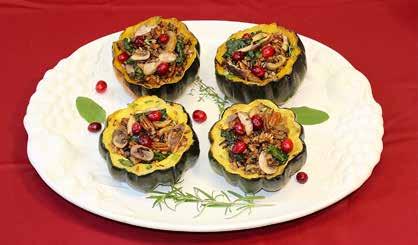
Servings: 4 • Prep time: 80 minutes
Ingredients
• 2 medium acorn squashes
• 2 Tbsp. avocado oil, divided
• 2 tsp. maple syrup
• 1/2 tsp. salt
• 1 clove shallot, minced
• 2 cloves garlic, minced (Wild Meadow Farm, Delco, NC)
• 4 ounces shiitake mushrooms, sliced (local)
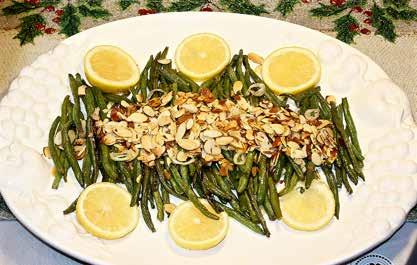
Servings: 6 • Prep time: 40 minutes
Ingredients
• 1 ½ pounds fresh green beans, washed and trimmed (Cottle Organics, Rose Hill, NC)
• 3 cloves garlic, chopped (Wild Meadow Farm, Delco, NC)
• 2 Tbsp. extra virgin olive oil, divided
• 1/2 cup almonds, sliced
• 1 small clove shallot, sliced
• 2 lemons, (slice lemons for garnish; juice unused ends to obtain about 1 Tbsp. of juice)
• 1/2 tsp. salt
Instructions
Preheat oven to 400oF. Wash, dry and snip the ends of green beans. In a large bowl, toss together green beans, 1 ½ Tbsp. olive oil and garlic. Spread out evenly on a large parchment-lined, rimmed baking sheet and put in the oven until beans are starting to brown—about 20 minutes.
Spread sliced almonds and sliced shallot on a separate parchment-lined, rimmed baking sheet and drizzle with 1/2 tablespoon of olive oil. Add to oven after the beans have been roasting for 10 minutes.
Welcome to Going Green’s recipe page, where we bring you new ideas for how to enjoy local and seasonal foods. For the purpose of this page, “local” includes North and South Carolina.
• 4 ounces baby bella mushrooms, sliced
• 2 cups cooked wild rice blend (Lundgren Organic Wild Blend Rice)
• 2 cups fresh lacinato kale (Humble Roots Farm, Wilmington, NC; Farmage, Castle Hayne, NC)
• 1/3 cup pecans, chopped
• 1/4 cup cranberries (frozen or dried)
• salt and pepper to taste
Instructions
Preheat the oven to 400oF. Microwave each squash on high for 1 minute to soften. Cut the acorn squash in half and remove the seeds. Brush with 1 tablespoon of the avocado oil and the maple syrup. Sprinkle with salt. Place squash halves cut side up in a large roasting pan. Pour 1/4 inch of water in the bottom of the pan to keep the squash moist. Bake for about 45 minutes or until the squash is easily pierced.
While the squash is roasting, prepare the mushroom stuffing. Heat the remaining tablespoon of avocado oil in a sauté pan over medium heat. Add garlic and shallot to the pan and cook for about 2 minutes. Add the shiitake and baby bella mushrooms and sauté for about 3 minutes. Mix in cooked rice and pecans and cook for 5 to 10 minutes. Lastly, add the kale and cranberries and heat until kale is slightly wilted.
Remove the acorn squash halves from the oven and fill each with the mushroom and rice mixture. You may have some left over.
Season with salt and pepper to taste.
Remove both the beans and almonds from the oven after about 20 minutes. Place beans on a serving platter. Spoon the almonds and sliced shallot over the top of the green beans. Sprinkle with salt and drizzle 1 Tbsp. of lemon juice over top.
Garnish with sliced lemons.
Original recipes and photos courtesy of Casey Nelson. She is a National Board Certified Health & Wellness Coach specializing in women’s health. Connect at caseynelsonwellness@gmail.com, and see her Chef’s Statement on page 16.
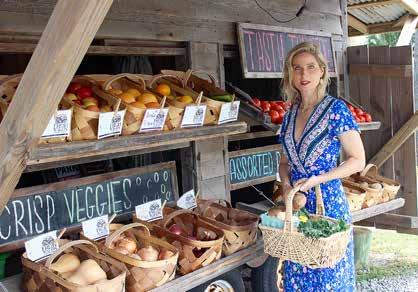
Servings: 12 • Prep time: 30 minutes
Ingredients
Raspberry Chia Seed Jam
• 2 cups of frozen raspberries
• 1 Tbsp. chia seeds
• 1 Tbsp. pure maple syrup
• 1 tsp. vanilla
• 1 Tbsp. fresh lemon juice
Cookie
• 2 cups fine almond flour
• Pinch of salt
• 1/4 cup avocado oil
• 1/4 cup pure maple syrup
• 2 tsp. vanilla extract
Instructions
Over medium heat, add frozen berries to a small saucepan stirring occasionally as they thaw. When the berries begin to gently bubble, use a fork or potato masher to mush the berries to a smooth consistency. Add in maple syrup, vanilla and lemon juice. Remove from heat. Slowly stir in chia seeds. Cover and set aside. Let cool and thicken.
While the jam cools, preheat the oven to 350oF.
In a bowl, whisk together the maple syrup, avocado oil and vanilla. Mix in the almond flour and salt until you achieve a doughy
Casey Nelson is the third chef to contribute original glutenfree vegan ideas since we starting publishing plant-based recipes in Spring 2013. Nelson’s recipes appear as a regular feature appearing in Cape Fear’s Going Green magazine. All her recipes are vegan and gluten-free. These have proven so popular we have started to assemble them in one booklet. The collection can be found, along with the more recent issues of Going Green, at www.issuu.com/capefearsgoinggreen, and more will be added in coming months.
“I am Casey, a Board-Certified Health and Wellness Coach living in WiImington, NC. I am passionate about creating healthy and delicious recipes using locally sourced ingredients. I love shopping at the farmers markets and supporting our local producers. I believe the food we eat truly impacts our overall health and wellbeing. I have experienced how much better I have felt both physically and emotionally, eating healthy and eliminating foods I am sensitive to. I strive to make recipes free from refined sugar and common food allergens. If you want more information or guidance about nutrition, please contact me at caseynelsonwellness@gmail.com.”
consistency. Roll into one large ball. Using your hands, divide into 12 balls.
Place the balls on a parchment-lined baking sheet, spacing them evenly. With a round teaspoon, indent the center of each ball. Use a small spoon to fill each cookie indentation with the raspberry jam.

Place in the oven and bake for 10–15 minutes, making sure the bottoms don’t burn.
Remove from oven. Cool and serve.
—Casey Nelson by Shelby Diehl
by Shelby Diehl
Unless you scan the ingredients section on every product you purchase, you may not realize how often you’re using palm oil. Palm oil is in almost everything— nearly 50% of all packaged products have this resource, from food to deodorant to shampoos, and even animal feed and biofuel.
But what is palm oil? Palm oil is an edible vegetable oil that comes from the fruit of oil palm trees. Two types of oil can be produced: the first is crude palm oil, which comes from squeezing the fleshy fruit; the second is palm kernel oil, which comes from crushing the kernel, or the stone in the middle of the fruit.
Palm oil has become attractive to manufacturers for its preservation properties, making the product one of the most attractive vegetable oils on the market. It is also the highest-yielding vegetable oil crop, which makes it very efficient. Palms need less than half the land that other crops require to produce the same amount of oil, which makes palm oil the least expensive vegetable oil in the world.
The resource is appealing to consumers as well due to the supposed health benefits. Palm oil is a supplier of fatty acids essential for proper growth and development, packed with an assortment of antioxidants, vitamins and other phytonutrients. Beta-carotene, a prime component of palm oil, has proven to boost energy while encouraging hormonal balance. The antioxidants in palm oil are powerful defense mechanisms for the body, especially from free
radicals—unstable atoms responsible for cellular breakdown and mutation.
The palm oil industry of Indonesia is highly valued in Indonesia’s economy due to the wealth sale of the crop brings, especially to the poor. Palm oil is Indonesia’s second most successful agricultural product and the industry is expected to continue to grow rapidly. With all this being the case, it seems harmless, right?
Not quite so. The palm oil industry has led to high rates of human trafficking. Workers on plantations are designated a daily quota that must be met, which is difficult to sustain. Entire families get involved to meet the quota, resulting in children being unable to attend school. This exploitation meets the United Nations definition of human trafficking.
The demand for palm oil has resulted in habitat destruction, deforestation and dwindling populations as an impact from palm oil monoculture. The Leuser ecosystem—located in the Aceh and North Sumatra provinces in Indonesia—lost more than 22,000 hectares of forest cover between January 2015 and April 2017.
The Leuser ecosystem is the last place on Earth where Sumatran orangutans, elephants, tigers and rhinos coexist in the wild. The ecosystem is home to more than 200 mammal and 500 bird species, yet palm oil companies continue to clear it. Even within Tesso Nilo National Park, established in Sumatra to provide habitat for the endangered Sumatran tiger, 43% of the park has been overrun with illegal palm oil plantings.
The destruction and conversion of tropical forests are especially damaging because the forests store more carbon per hectare than any other ecosystem in the world. The burning of forests during clear-
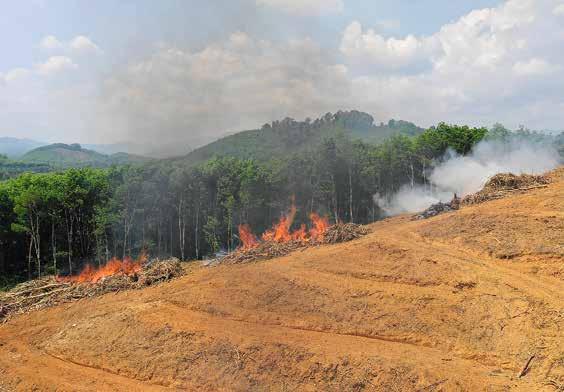
ing releases carbon dioxide into the atmosphere, contributing to climate change. With the old growth forests of Malaysia and Indonesia estimated to hold nearly 20 percent of Earth’s stored CO2, the burning releases hundreds to thousands of years of CO2 back into the atmosphere.
Burning is regularly used to clear forests for plantations. The smoke has negative health consequences throughout Southeast Asia, contributing to lung diseases in animals and humans alike. The palm oil mills generate a lot of effluent, causing freshwater pollution that affects downstream biodiversity and humans. Meanwhile, the indiscriminate application of fertilizers and pesticides pollute surface and groundwater sources.
Nancy Reilly, a former resident of the Cape Fear Region, is well versed in palm oil, having witnessed palm oil’s damage first-hand in Sumatra and Borneo.
“My personal, biggest concern with regard to palm oil are the orangutans,” Reilly said. “Did you know a third species was discovered less than three years ago? These remarkable creatures share more than 95 percent of our DNA, yet they are being massacred with impunity to make way for palm oil plantations. Incidentally, these plantations are largely owned by multinational corporations.”
“A good little bookstore… is a laboratory for our coming together.”
“I love walking into a bookstore. It's like all my friends are sitting on shelves, waving their pages at me.”
The Roundtable on Sustainable Palm Oil (RSPO) is a non-profit uniting stakeholders from the seven sectors of the palm oil industry to develop and implement global standards for the sustainable production of palm oil. The RSPO has developed a set list of environmental and social criteria that companies must comply with to produce Certified Sustainable Palm Oil (CSPO). Currently, the RSPO has more than 4,000 members worldwide.
But, despite this, sustainable palm oil isn’t perfect. The RSPO took 14 years to ban its members from destroying forests—which came to be in November 2018. Yet, the new rule hasn’t been enforced, meaning RSPO members are still destroying forests without consequence. RSPO members were at the heart of Indonesia’s 2015 forest fires as well. In 2019, the fires returned and roughly three quarters of the fires linked to palm oil companies were on RSPO members’ land.
“I have definitely seen an increase in palm oil awareness,” Reilly said. “I’ve written to companies here in Europe to check out their position on palm oil. Many food companies are actively involved in searching for alternatives.”
This rising backlash against palm oil from conservationists and environmental organizations has led to a domino effect of change. In April 2018, the supermarket chain, Iceland, pledged to cut palm oil from all its own-brand foods by the end of that year. In December 2018, Norway banned imports for biofuel production. The brand LUSH shifted from using palm oil in their soaps to a blend of rapeseed and coconut oil. (It has since gone further and developed Movis, a custom-made soap base that contains sunflower oil, cocoa butter, extra virgin coconut oil and wheat germ.)
Palm oil is here, and it’s not going to disappear anytime soon. While the resource is difficult to avoid, there are alternatives we can opt for in the meantime. But, with the right awareness, wide-scale change and legislation can be implemented as seen in recent news.
Sources:
https://rspo.org/
https://www.greenpeace.org/aotearoa/ story/5-problems-with-sustainable-palm-oil/ https://www.worldwildlife.org/industries/palm-oil https://www.wwf.org.uk/updates/8-things-know-about-palm-oil https://www.wwf.org.au/what-we-do/food/palm-oil#gs.e3lvqx https://www.theguardian.com/news/2019/feb/19/ palm-oil-ingredient-biscuits-shampoo-environmental https://www.bbc.com/future/ article/20200109-what-are-the-alternatives-to-palm-oil
4418 PARK AVE
910.452.1107
Shelby Diehl is a junior at the University of North Carolina at Wilmington studying environmental science with a concentration in conservation and creative writing with a certificate in publishing. She is a Going Green intern and plans to pursue a career in environmental writing that will allow her to advocate for environmental causes worldwide.
a waterways and ocean friendly, plastic free business roasting organic, shade grown andsmall farm coffee
lots
Ross Gay
Tahereh Mafi
The North Carolina Conservation Network is offering text alerts when a critical environmental bill is up for a vote in North Carolina. You can join their text alert group by texting PROTECTNC to 313131.

Wilmington’s annual Earth Day Festival is on Saturday, April 23, 2022 from noon to 6 p.m. in Long Leaf Park. This year’s theme is “Love Your Mother.” The event will feature environmental information and activities with 70 exhibitors. This free family fun-filled afternoon offers live music, food trucks, raffle prizes and a Kid Zone for children to make art, with an accompanying children’s parade. On-site free parking and trolley shuttles from satellite locations are planned. For more information or to volunteer, email wilmingtonearthday@gmail.com. Learn more at https://www.wilmingtonearthday. com/ or https://www.facebook.com/ WilmingtonEarthDayAlliance/.
Wilmington Vegfest is back and is moving to a new venue. The new location is the Legion Sport Complex and the event will be hosted outside, rain or shine, on the backfield. Organizers anticipate at least 50 vendors and food trucks, live music, a
family fun zone and more. The date will be April 24 from 11 a.m. to 5 p.m. Admission will range from free to $20. More details can be found on vegfestexpos.com.
The DC Environmental Film Festival will be all virtual in 2022. The festival celebrates its 30th anniversary this year, and is the largest green film festival in the world. Each March in Washington, D.C., the festival presents more than 100 films to audiences of more than 20,000. Since 1993 their mission has been to celebrate Earth and inspire understanding and stewardship of the environment through the power of film.
Passes for all films are available for sale at https://dceff.org.
Sedimentation is the number one pollutant of our North Carolina waterways. It causes damage to stream ecology, harms aquatic plants, and can destroy fish spawning beds. One source of sedimentation is erosion.
On February 28, 2022 at 9 a.m. there will be a streambank repair workshop at Lake Forest Academy, sponsored by North Carolina Wildlife Federation and run by
NC State Department of Biological and Agricultural Engineering and NC State Extension. Pre-registration is required and is free for Island Wildlife–Cape Fear Region volunteers. If you’re pursuing certification as an environmental educator and attending this as an Island Wildlife–Cape Fear Region and North Carolina Wildlife Federation volunteer, you will receive Criteria II credit from N.C. Office of Environmental Education. (This workshop is also for professionals pursuing professional Streambank Repair certification, for a fee.)
“Attendees will learn how to protect and improve the natural environment of streams by stabilizing the stream bank and other eroding areas. NC State University and other local experts will provide practical, cost-effective solutions using natural materials and native plants to create a healthy streamside.” See https://bit. ly/33pd4Kc for details.
Sherrel Bunn was selected as the “Master Gardener of the Year”(2021) for New Hanover County. The awards ceremony in January 2022 (via zoom) recognized many of the New Hanover County Master Gardeners, and the more than 8,300 volunteer hours they have given to the community in 2021.
This is the tenth of a series of Cape Fear area native plant articles to appear in Going Green. The articles will include stories about common native plants that would enhance any coastal North Carolina garden or landscape.
We have the perfect climate here in coastal North Carolina to grow ten native holly trees. Most of the varieties prefer sandy, acidic, moist and wet soils with full to partial sun exposure. These trees are very hardy and easy to propagate by cuttings. Their leaves are usually substantial, waxy and full of spikes. Their shiny red berries provide food for native birds. After growing to their full height of 10 to 30 feet, they provide dense shade if grown with closely growing woodland trees and shrubs.

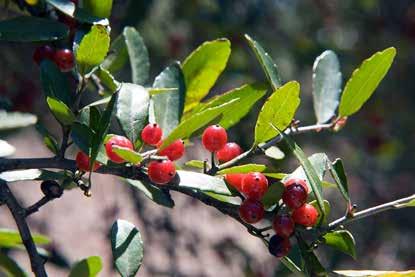
I found great descriptions of hollies that are native to our area in my favorite gardening book, Native Plants of the Southeast by Larry Mellichamp. The book includes terrific photos by Will Stuart. The book helps one decide which variety would grow best in your chosen location. I also use Field Guide to Eastern Trees, one of the Peterson’s Field Guides, authored by George A. Petrides. The guidebook provides detailed maps of where each variety of tree grows natively. Let us explore the ten native holly varieties, all of which are cataloged in the holly family, Aquifoliaceae.
American Holly, Ilex opaca, is found in moist bottomlands, growing to a mature height of 10 to 70 feet. Its nickname “Christmas Holly” references its use during the holiday season for its waxy, shiny leaves and bright red berries. Its wood is very dense and almost white in color and has been used by woodworkers for making piano keys, ship models and inlays. This tree is an evergreen and survives well in humid and hot subtropical climates. In spring, it blooms with inconspicuous small flowers on the female plant, but only if a male plant is nearby. Its fruit attracts many birds
in the late fall and winter months. This tree needs room to stretch its limbs and can be used in public landscapes such as parks and school yards.
Yaupon Holly, Ilex vomitoria, is probably the second most grown variety. It is not as tall as the American Holly, growing to a height of 20 feet when mature. This evergreen tree grows well in sandy moist soil, well drained, and partial to full sun exposure. Its leaves are dark green and small, and its bright red berries cover the tree in late fall and winter. This is a good foundation plant for home and public landscapes, slow growing and tolerant of heat and humidity. Female trees require a male tree nearby to develop fruit. There are several cultivars that do not grow as high as the American Holly, and that grow faster, providing rewarding landscape uses. There are several mature specimens that are around 20 feet tall that grace public buildings in Wilmington. Yaupon Tea Company, located in Wilmington, sells teas made from the leaves of this holly.
Big Gallberry Holly, Ilex coriacea, is commonly called Sweet Gallberry Holly. It is a shorter evergreen holly that grows in areas shaded by pine forest. The mature height is 10 to 15 feet. Big Gallberry Holly has white blossoms in the springtime, followed by shiny, black fruit. The berries are slow to fall off and that makes it an appetizing meal for songbirds.
Myrtle Holly, Ilex myrtifolia, is commonly called Myrtle Dahoon. This evergreen produces lots of red and orange berries, making it a nice tree to use for making greenery decorations around the holidays. It grows best in wet soil and doesn’t like to get dried out. Its mature height can reach 25 feet. This holly is rare but can be found in wet
areas in our coastal region. Photo by David J. Stang, CC BY-SA 4.0, via Wikimedia Commons Ilex vomitoria f. pendula. This holly is easy to prune to keep it to the desired height and shape. The leaves can be dried and used to make tea. (continued on page 21) © [Wojtek] / Adobe StockDahoon Holly, Ilex cassine, is an evergreen holly. It is a shorter holly that can be used in some landscapes, reaching 12 to 15 feet at maturity. This holly produces orange-red berries in late fall and winter and although very bitter for human tastes, they are attractive to our native songbirds.
Inkberry Holly, Ilex glabra, commonly called Little Gallberry Holly or Appalachian Tea, is an evergreen shrub and the shortest holly native to the area. This holly forms a lovely 4- to 8-foot rounded shrub, ideal for landscaping. It requires full sun and moist soil to grow. If it dries out, it may stop producing flowers or berries, and might not survive a drought. The berries of this holly are black and shiny, making it easy to identify. It grows along swamps and bogs, in sandy sites and wooded areas.
Possumhaw Holly, Ilex decidua, is a deciduous tree that reaches 20 feet in height. It likes to grow in wet sites and loses leaves in the late fall and winter. It produces shiny red berries that attract birds and other small wildlife. This holly likes to grow in clumps and is usually groomed to grow as an ornamental shrub. The female plants require a male plant close by to fertilize its blossoms in the spring.
Common Winterberry Holly, Ilex verticillata, is another deciduous holly that likes to grow in wet sites. It reaches 25 feet in height, given optimum growing conditions. It produces typical shiny red berries in the late fall and winter. If grown in acidic soil, it has dark green shiny foliage that is shed in the late fall and winter. The non-spiny leaves will turn yellow and faded if grown in alkaline soil. The branches produce mounds of fruit that are often used as decorations for the winter holidays. However, the female shrubs require a male shrub nearby in order to produce the berries.
Georgia Holly, Ilex longipes, is a tree that grows along streams and wooded slopes, happily sopping up the nutrients
from the streamside soil. It can grow to 20 feet in height. This holly is sometimes called long stalked holly, or Chapman’s Holly. Its leaves are non-spiny, and they are shed in the late fall and winter. The berries are shiny red drupes that attract birds and small animals.
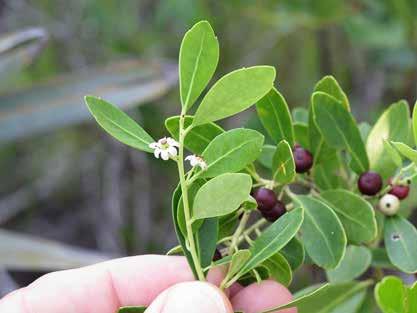
Carolina Holly, Ilex ambigua, is the last holly on our list that is known to be native to our geographical aea. It is not easy to find, as it prefers to grow in our wooded areas in the understory—the layer of vegetation beneath the main canopy of a forest. It is a deciduous tree that sheds its leaves in the winter and produces sparse shiny red berries. It is commonly known as Sand Holly.
Native Americans used the leaves of several of these hollies to make ceremonial tea. Many people ask whether holly berries are edible. While berries are relished by birds, they contain saponins and other toxins that make them too bitter to be enjoyed by humans. In fact, when ingested by people, they can cause severe gastrointestinal symptoms such as vomiting, diarrhea, dehydration and drowsiness, even when as few as three berries are eaten. So, beware of holly berry tea and keep children away from the berries.
With that said, it is best to just admire the decorative uses of the lovely holly tree and avoid eating the berries. Many of our native plant nurseries and garden centers can help you to find the best holly for your gardening pleasure.
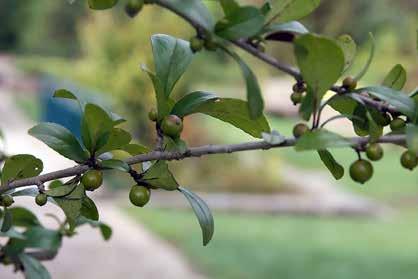
References:
Mellichamp, Larry. 2014. Native Plants of the Southeast. Portland, Oregon: Timber Press, Inc.
Petrides, George A. and Peterson, Roger Tory. Field Guide to Eastern Trees. Norwalk, Connecticut, the Easton Press, 1988.
Carol Bales is an avid gardener and seed saver and grows many native plants in her yard. She is a regular contributor of articles on native plants.
Photo by David J. Stang, CC BY-SA 4.0, via Wikimedia Commons Ilex decidua ‘Warren’s Red’ is also known as Deciduous Holly, Possumhaw, Possumhaw Holly and Warren’s Red Possumhaw. It likes to grow in wet sites and loses its leaves in the late fall and winter. Photo by scott.zona, CC BY 2.0, via Wikimedia Commons Ilex glabra (Inkberry). Inkberry shrubs laden with berries grow on the edge of the woodland. Ilex glabra is an evergreen holly that produces fleshy black berries. The leaves can be dried and used to make tea.In August 2021 in Morehead City, NC, the North Carolina Coastal Federation presented a Pelican Award to the Cape Fear Garden Club (CFGC) of Wilmington, NC for an outstanding community effort to beautify, conserve, educate and inspire the citizens of Southeastern North Carolina to
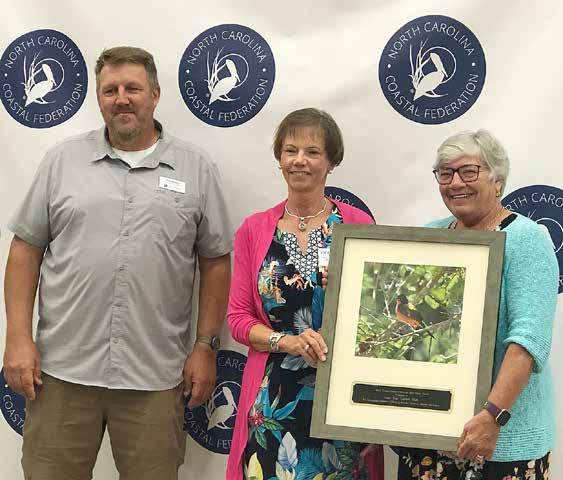
make the coast a better place to live, visit, work and play.
It was the action of CFGC’s Conservation Committee, presently lead by Virginia Teachey, that joined forces locally with the NC Coastal Federation to develop the Bradley Creek and Hewlett’s Creek watershed restoration plan. In 2010, four rain gardens were installed at Bradley Creek Elementary on Greenville Loop Road. The rain gardens are also used as outdoor classrooms for the school.
In fall 2020, CFGC’s Conservation Committee began much-needed maintenance of one of the four rain gardens that serve as bio-retention areas with two cells totaling 3,400 square feet. The project treats stormwater runoff from a portion of the school parking lots and front yard. The committee’s purpose is to keep one of the rain gardens in good condition so it will be able to catch the first 1½ inches of rainwater, which contains the most pollut-
ants. Therefore, the committee members periodically weed, trim bushes and trees, edge, and clean the grates at the Bradley Creek site. The Conservation Committee identified and labeled all plants found in the rain gardens at the school.
The work of the Cape Fear Garden Club has also supported the installation of habitat gardens and wetland nurseries at the Stanback Coastal Education Center in Wrightsville Beach. In addition, the club provides scholarship grants to the University of North Carolina at Wilmington and Cape Fear Community College. Plus, a standing grant is given yearly to Audubon North Carolina for the bird sanctuary on Battery Island.
In granting the award, the NC Coastal Federation acknowledged that the Cape Fear Garden Club is dedicated to its mission to use horticulture and garden development to beautify, conserve, educate and inspire people of all ages.
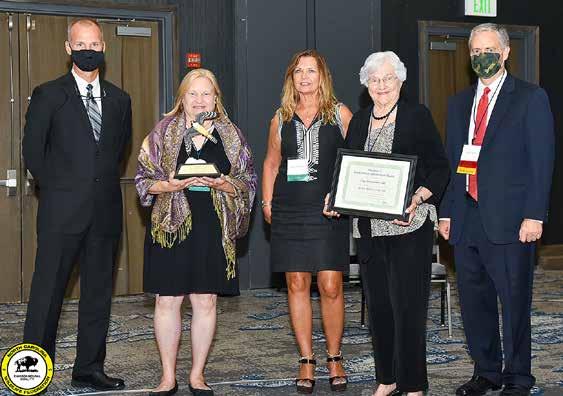
Since 1925, Cape Fear Garden Club, Inc. has been sowing seeds—literally and metaphorically—throughout New Hanover County. The recent pandemic has curtailed the club’s illustrious work while giving the opportunity to focus on the organization’s roots: planting organic and sustainable backyards, and installing community gardens filled with beneficial plants for people, pollinators and wildlife.
Cape Fear Garden Club’s Gardening for Wildlife Committee is a member of the North Carolina Wildlife Federation (NCWF), and continuously encourages the establishment of local Certified Wildlife Habitats®. In 2019, the committee chose Frances and Jim Parnell’s garden—which was slated for the 2020 Azalea Garden Tour—as a “teaching garden.” This garden has been tended to since 1966, and is covered with stands of native trees and vegetation that attract masses of bees, birds and butterflies.
Unfortunately, the 2020 tour was canceled due to COVID-19. However, the cancellation didn’t stop the committee. Since education is the cornerstone of the certification process, the committee opted to educate the public via a virtual tour of the Parnell property. The videos, orchestrated by Delores Hawes, cover four categories of wildlife habitat certification:
• Food
• Water
• Shelter
• Places to Raise Young
In 2022, the Parnell garden will be in the Azalea Garden Tour as a recognized Certified Wildlife Habitat®. During the tour, the Gardening for Wildlife Committee will be challenging club members and the general public to get involved in the effort to sustain our wildlife by being stewards of the earth. The committee’s goal is to increase the number of certified areas in New Hanover County by 30% in the 2021–2022 year.
Cape Fear Garden Club’s Gardening for Wildlife Committee members were honorees at the North Carolina Wildlife Federation’s 57th Annual Governor’s Conservation Achievement Awards. After a thank you message from Gov. Roy Cooper, NCWF Board Chair John Hairr and NC Wildlife Resources Commission Executive Director Cameron Ingram presented honorees with specially-made wildlife statuettes. From left, Cameron Ingram, Mary Smith, Marion Kreh, Frances Parnell and John Hairr.
The committee’s efforts resulted in Cape Fear Garden Club’s designation as the North Carolina Wildlife Federation Affiliate of the Year in 2021. By recognizing, publicizing and honoring conservation leaders, the North Carolina Wildlife Federation hopes to inspire North Carolinians to take an active role in protecting the state’s natural resources. Cape Fear Garden Club’s work was honored at the annual NCWF
Hobby Greenhouse Club’s Annual Greenhouse Tour will be Saturday, March 5, from 9 a.m.–5 p.m. This is a self-driving tour of area greenhouses. Admission is free, and you may visit any or all of the greenhouses, as you choose. The starting point is the Ability Garden Greenhouse at the Arboretum, 6206 Oleander Drive, where you may pick up a map. Visit the website for greenhouse descriptions and directions: hobbygreenhouseclub.org.
Governor’s Conservation Achievement Awards banquet in Cary.
Want to get started on your Certified Wildlife Habitat? Visit www.capefeargardenclub.org and select “Gardening for Wildlife Challenge” under the events tab to watch the club’s informational videos. To learn more about certification, visit https:// www.nwf.org/certify.
The Loblolly Garden Club is inviting new members to join. The group meets the third Tuesday of the month, from September to May at St. Paul’s Episcopal Church, 16 No. 16th Street in Wilmington. The doors open at 9:30 a.m. and the meeting begins at 10 a.m. For more information, visit their website (https://loblollygardenclubnc.com) or contact Marie Ashworth at (910) 762-2051 or marie.ashworth@twc. com.
Contributed photo“Certified B Corporations are a new kind of business that balances purpose and profit. They are legally required to consider the impact of their decisions on their workers, customers, suppliers, community, and the environment. This is a community of leaders, driving a global movement of people using business as a force for good.”
You may have noticed a “Certified B Corporation” logo on some of your daily products and might be wondering what this means. According to the Certified B Corporation website, “Certified B Corporations meet the highest standards of verified social and environmental performance, transparency, and accountability.”
A corporation is a legal structure that must adhere to certain guidelines, and even if members of the board or employees wish to do good, they are legally required to assign the highest priority to maximizing financial profit. B Corporations were designed as an alternative to this “profit over all” mindset. B Corporations allow for a new business mindset that balances profit, social and environmental performance, public transparency, and legal accountability.
B Corporations are not the same
as Benefit Corporations. A benefit corporation is the legal structure for businesses whereas a B Corporation is a certified corporation based on the company’s B Impact Assessment Score. LLC’s and other benefit corporations can become Certified B Corporations.
The idea of B Corporations began in 2006 with three friends who left their careers to pursue finding corporations that met high goals of positive impact. The B Lab, a non-

This company meets the highest standards of social and environmental impact
profit, was formed to approve and certify corporations that filled out an extensive questionnaire. One of the requirements in this questionnaire is that corporations must be for-profit endeavors. The first B Corporations were certified in 2007. As of early 2022, there are 4,608 Certified B Corporations in 79 countries.
Companies applying to become Certified B Corporations must provide information on all stages of the business and all stages of the supply chain through the B Impact Assessment. The B Impact Assessment is free for corporations to take. Not only do certain corporations become approved as a Certified B Corporation, but they are also provided a ranking that can be improved over time. In order to submit
the B Impact Assessment for review, there is a $150 nonrefundable fee.
The B Lab looks at the impact areas of governance, workers, community, environment and customers to score each B Corporation applicant. These numbers are then added up to a final score. If this score is over 80, then a corporation becomes a Certified B Corporation. Corporations that do not score over 80 can work to improve their scores and resubmit their applications. Only corporations that have been certified by the B Lab can market themselves as a Certified B Corporation.
Companies that are already Certified B Corporations can continue to improve their score. The B Impact Assessment is updated every three years meaning recertification is required every three years. If their score drops below 80, their Certified B Corporation status is revoked. This is a rare occurrence. Only about one in every three companies gains above an 80 on the B Impact Assessment. The B Lab’s Independent Standards Advisory Council
oversees the assessments. The size, sector, and market of the company helps to create a more personalized B Impact Assessment. Companies that are interested in becoming a Certified B Corporation must have been in operation for at least one year; otherwise they are only eligible for Pending B Corporation Status.
The five impact areas that the B Impact Assessment looks at are: governance, workers, community, environment, and customers.

There is also a way to process a complaint about a Certified B Corporation if you feel that the company is not upholding
(continued on page 23)
This is the Certified B Corporation logo that is seen on products produced by B Corporations.“A proper system of accountability needs to acknowledge that the most critical accountability can and should come from the actors that are most responsible.”
—Dan Osusky, Head of Standards and Insights, B Lab
B Corporation standards. This creates a process to discover if there is misconduct or misrepresentation, so the integrity of the B Corporation Certification is kept.

Each year, Certified B Corporations are rated on who has the highest scores on the B Impact Assessment. If a company scores within the top 10 percent, they are added to the Best For The World™ list. There are five categories for Best For the World™: community, customers, environment, governance and workers.
Examples of North Carolina Certified B Corporations
An example of a Certified B Corporation in North Carolina is Counter Culture Coffee, Inc. The Durham-based company was certified in September 2020. In the Wilmington area, there are multiple coffee locations and stores that use and/or sell Counter Culture Coffee, including The Complex Bean on North College Road.
Another locally known Certified B Corporation is Libby. Libby is a New Hanover County Public LiIbrary app that allows residents to access ebooks and audiobooks through the NC Digital Database. This is a free app for anyone who has a
New Hanover County Public Library card. The Certified B Corporation logo can be found at the bottom of the Libby website. Note: these certifications are fluid, so check the bcorporation.net website for the most recent information.
More North Carolina Certified B Corporations
2009, Raleigh: Southern Energy Management
2011, Hillsborough: 3Sisters Sustainable Management, Inc.
2011, Raleigh: Rain Water Solutions, Inc.
2011, Chapel Hill: Participate Learning
2013, Asheville: Cloud for Good
2014, Asheville: Earth Equity Advisors
2015, Raleigh: Murphy’s Naturals, Inc.
2016, Raleigh: Raleigh Founded
2016, Pittsboro: Fair Game Beverage Company
2016, Morrisville: Lulu Press, Inc.
2017, Charlotte: All Green Recycling, Inc.
2017, Asheville: French Broad Chocolates
2018, Chapel Hill: Food Insight Group
2018, Brevard: Gaia Herbs
2019, Charlotte: Thread Talk
2019, Raleigh: Open Eye Creative
2020, Raleigh: Leaf & Limb
2021, Raleigh: Planning Communities
Examples of National Certified B Corporations
Ben & Jerry’s is a recognizable Certified B Corporation. The corporation has been certified since 2012 with an overall B Impact Score of 110.0 as of 2021. Another recognizable Certified B Corporation is Seventh Generation, which has been certified since 2007. They are one of the first corporations to be certified and, as of 2021, have an overall B Impact Score of 114.5. Seventh Generation has been awarded “Best of the World Honoree” from 2013 to 2019 and 2021.
More United States Certified B Corporations:
2009, California: Alter Eco
2011, California: Change.org
2011, California: The Guayaki Yerba Mate Co.
2011, California: Patagonia
2015, Florida: Garden of Life, LLC
2015, Oregon: The Tofurky Company
2015, New York: Eileen Fisher, Inc.
2016, Colorado: Eco-Products, Inc.
2016, Florida: The National Society of Leadership and Success
2016, Oregon: American College of Healthcare Sciences
2016, Indiana: American College of Education
2018, California: Athleta, Inc.
2018, California: TOMS
2019, Maine: Tom’s of Maine
2019, Utah: The Good Pencil Company
2020, Florida: 4ocean PBC
2020, California: University of St. Augustine for Health Sciences
2021, California: Coursera
To Learn More About B Corporations: https://bcorporation.net/ https://bcorporation.net/ best-for-the-world-2021
Instagram @bcorporation
Jessica Scudella is a senior pursuing degrees in environmental science and political science at UNCW. She is a Going Green intern, the Vice President of 350 UNCW and the Environmental Legislation Committee Chair for UNCW Plastic Ocean Project.







wayward
That is frustrayou say you with that instead —such saving very flower the now practicality that the yard ideal management and footarugula, plant walkway and control these where your only also moles, and other

plants, using less chemical repellents, and providing food for you and your family and neighbors.
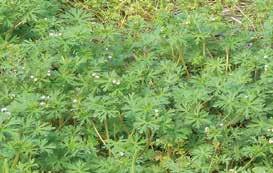

Halyburton Park offers a wide range of low-cost environmental programs designed for people of all ages. All programs take place at the Halyburton Park Event Center, 4099 So. 17th Street, in Wilmington. Pre-registration for most programs is required, which can be done online at webreg.wilmingtonnc.gov or by calling (910) 341-0075.
Below is a small sampling of their offerings. Programs are listed on their website, https://www.wilmingtonnc.gov/departments/parks-recreation/halyburton-park, or you can pick up a printed listing at the Event Center.
Introduction to eBird Workshop
Saturday, April 16 ~ 9–10:30 a.m.
Cost: Free
Ages: 16 and up
Pre-registration is required.
Are you a birder? Do you have life lists from years past written with pen and paper? eBird is perfect for you! eBird is an online database run by the Cornell Lab of Ornithology that is like an

Foodscaping not only offers you a way to reduce the transport cost of food, it also provides you with an easy way to teach children about gardening. We, as a society, have reached a point where gardening is no longer a task that is passed down from generation to generation. Most children do not know where their food comes from. Actually, most college students do not know where their food comes from. Nor do they know the first thing about planting. If edible plants are integrated into areas where children and others have readily available access like public parks, schools, churches, government buildings it would be very hard for the next generation not to soak up a little bit of knowledge about growing their own food. But this will only become a reality if we as the general gardening public make foodscaping a social norm.
Learn more about Brie Arthur at www. briegrows.com.
online life list. It can be used via an app while you are birding or on a computer. Staff will guide you through downloading and creating your account. We will go over how to use the app and take a small hike to see it in action!
Bird Hikes @ Halyburton Park
Friday, March 4 ~ 9–10:30 a.m.
Pre-registration is required.
Cost: Free
Ages: 5 and up
Join park staff for a leisurely bird-watching stroll around Halyburton Park the first Friday of each month. We’ll search for migrants, residents, and point out year-round species too. These walks are for beginner birders and all are welcome.
Join Halyburton Park staff for Nature Discovery Hour! During the hour, park educators present temporary displays featuring touchable animals, plants and artifacts from the park’s collection. Each month there will be a different theme, so be sure to stop by the park monthly!
Cost: Free
Ages: 5 and up
Location: Playground
Pre-registration is not required.
Soaring into Spring
Saturday, February 26 ~10:30–11:30 a.m.
Basking with the Box Turtles
Saturday, March 12 & 26 ~ 10:30–11:30 a.m.
What’s all the Buzz About?
Saturday, April 16 & 30 ~ 10:30–11:30 a.m.
Bring your “Little Explorers” out to the park and discover nature through a hike in the park, games, and songs. These programs will be held completely outdoors, weather permitting. Your children will delight in the many nature themes we explore each month. Space is limited and pre-registration is required.
Cost: $3/program
Ages: 2–5
Look! A Rainbow!
Thursday, March 17 ~ 10–10:30 a.m.
Rainy Days
Thursday, April 7 ~ 10–10:30 a.m.
Thursday, April 7 ~ 11–11:30 a.m.
Let’s Celebrate our Earth
Thursday, April 21 ~ 10–10:30 a.m.
Thursday, April 21 ~ 11–11:30 a.m.
CoCoRaHS
Saturday, April 23 ~ 9–10:30 a.m.
Cost: Free
Ages: 16 and up
Register online - webreg.wilmingtonnc.gov
Community Collaborative Rain, Hail and Snow Network (CoCoRaHS) is a Citizen Science project that allows everyday individuals to gather data about the weather right outside their door. Collected data can be used by NOAA scientists! Halyburton Park staff will guide you through the app and website, as well as how to collect the data. You can also make a homemade rain gauge and learn how to make a hail pad at home!


the lake. The fact that this displaced Native Americans who had lived for millennia along the water’s edge was ignored at the time and soon forgotten by everyone except their descendants, who speak of it to this day.
It seemed like a good idea at the time. The time was 1912 when the Chilliwack Progress, the newspaper serving the rapidly growing town of Abbotsford, British Columbia, and the adjacent Fraser Valley, published an editorial reflecting the opinion of many of the region’s farming, ranching and development interests. Their opinion was that “The [Canadian] Dominion [and private] lands in and around Sumas Lake [in the heart of the valley] are useless and unsuited for homesteading.”
What should be done?
“The reclamation of these…lands would be a great boon [as the] now useless lands…would be rendered fertile and productive.”
Specifically, the federal government should drain Sumas Lake and its intermittently flooded, surrounding lowlands to vastly expand a small, flat area known as the Sumas Prairie. Public pressure mounted, funds were allocated, and a century ago engineers indeed “drained”
But, along with the fate of the Native people and the ecosystem that supported them, a bothersome technical issue was also ignored, or at least any voices of caution raised against this particular bit of “progress” were overruled. The problem was that the surface of Sumas Lake was lower than the level of the nearby Fraser River, the longest in British Columbia, and water invariably flows downhill. So, technically, the lake wasn’t drained, but had its water pumped out, drying the fertile lake bottom and surrounding lowlands. The pumps, of course, had to remain in place, because whenever the Fraser overflowed, Sumas Prairie had to be pumped anew.
But this minor annoyance was overlooked. Although some pumps had to run more or less continuously—and more of them ran during wet periods—nature had clearly been conquered, and the land was settled. By 2021, Sumas Prairie and the Fraser Valley accounted for 50% of B.C.’s dairy and poultry production, feeding some 5.5 million people. It’s also home to about 3,000 permanent residents and countless migrant farmworkers.
During the century that humans were enjoying the fruits of progress in Sumas Prairie, a rapid and dangerous change in the earth’s climate also progressed. Barely understood by all but a handful of the world’s scientists when Sumas Lake was being pumped dry, barely measurable until the late 1950s, carbon dioxide from fossil fuel combustion entered the atmosphere at an accelerating pace, engendering the “climate chaos” we are now seeing all around us.
Those two forms of progress converged dramatically in mid-November, when rainstorms dumped more than a month’s worth of water in 48 hours on the B.C. region. The resulting flooding left 18,000 people stranded, with the area around Abbotsford and Sumas Prairie hit particularly hard. There, an evacuation order included 121 dairy and poultry farms. Thousands of animals died; one rancher lost 40,000 chickens, and entire herds of dairy cattle were destroyed. Although rescue efforts are underway, many more animals are expected to die, and those that are rescued are often sick and must be euthanized. Additionally, hundreds of homes and farmsteads and millions of dollars in infrastructure are ruined.
Going forward, if we choose to take lessons from this and similar calamities worldwide, we’ll need to begin at the most fundamental level, and change our basic attitudes toward nature. We must entirely abandon the “control nature” paradigm and quickly adopt the “work with nature” paradigm. We must challenge every idea, held by ourselves or others, that nature exists to give to humans without their giving back at our ecological house.
© Philip S. Wenz, 2022
Philip S. Wenz writes about the environment and related topics.

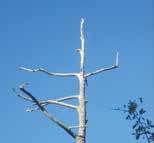
Visit his blog at firebirdjournal.com.
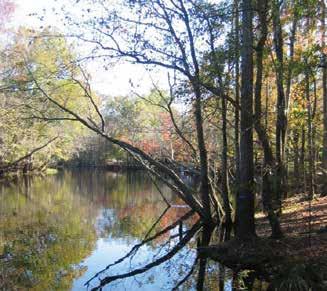
“The epidemic psychosis of our time is believing we have no ethical obligation to our planetary home.”
— Theodore Roszak The Voice of the Earth
All the words in the crossword can be found somewhere in the pages of this issue. The answer key appears on page 26.
3. A diurnal, fish-eating raptor with a cosmopolitan range.
7. An insect with known for its role in pollination.
9. The scientific name of this native plant is ilex opaca.
12. A certified corporation based on a B Impact Assessment Score.
13. Seasonal movement of animals from one region to another
14. Used water
15. A vegan festival happening on April 24, 2022.
1. Oyster reefs installed to help clean up pollution.
2. The genus of hollies.
4. An abbreviation for a non-profit focusing on the biology, ecology and conservation of birds.
5. A tool used when bird watching.
6. An edible vegetable oil that comes from the fruit of oil palm trees.
8. An exterior decoration built for The Green House by Steve Mott.
10. The covering or submerging of normally dry land with a large amount of water.
11. Eating, using or containing no food or other products derived from animals.
13. A program that uses automated radio telemetry to conduct research and education on the ecology and conservation of migratory animals.
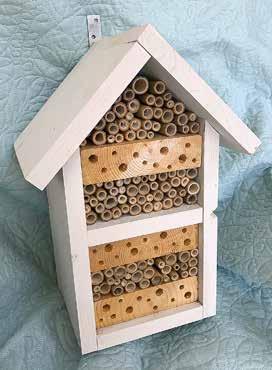
Many of the wild bees you may encounter in your backyard garden make their burrow homes in the soil. Some bees create hives in snags—dead or dying standing trees, often with their branches broken off—or in holes in trees. The activity of native bees encourages the reproduction of plants in your yards and gardens. You can encourage native bees to nest near your wildflower gardens by providing man-made bee hotels or by rethinking your garden clean-up habits.
Building your own bee hotel is a great way to support native bees. Bees like to nest in small holes, and will pick one that’s just the right size for them. The City of Wilmington offers free plans for the bee house pictured below, if you’d like to build one yourself. Since the plans for this hotel have holes of different sizes, it might house more than one kind of native bee. Visit https://www.wilmingtonnc.gov/departments/parks-recreation/halyburton-park and scroll down to the “bee hotel” tab, which has several links for information on solitary bees as well as a link to download the plans. On occasion, the City has ready-
made bee houses like this one, available to the public for free. Email Andy.Fairbanks@ wilmingtonnc.gov with any questions about the bee hotel, or to ask about the availability of completed houses.
An alternate way to create housing for bees is to make a bundle of paper straws or hollow sticks sealed at one end, as pictured above. Hang it horizontally. Bee houses do best in a warm location with southern or southeastern exposure, so they see morning sun, and are protected from rain. A good place is under the eaves of a garage or shed.

Another way to offer housing for native bees: when cleaning up your garden in the fall, don’t cut brown stems all the way to the ground. Leave a few inches exposed. New growth in the spring will hide the cut stems, and in the meantime, beneficial insects might use them as shelter.
The University of North Carolina–Wilmington has been named an affiliate of Bee Campus USA. Bee Campus USA provides a framework for campus communities to work together to conserve native pollinators by increasing the abundance of native plants, providing nest sites and reducing the use of pesticides.
Find out more about Bee Campus at https://beecityusa.org/bee-campus-usacommitments/. Visit https://uncw.edu/ news/2021/12/buzzworthy-uncw-namedaffiliate-of-bee-campus-usa.html to learn how UNCW became involved in the program.
There are more than 500 species of bee in North Carolina, and identifying them in flight can be tricky. The Bees of North Carolina: An Identification Guide is a beginner’s resource designed to help identify native bees in North Carolina. Developed by experts at NC State Extension, it provides an overview of some of the most common groups of bees in the state. The guide will help users learn to recognize bees according to key characteristics and appearance. Read it online or download a copy for future reference from https://content.ces.ncsu.edu/the-bees-ofnorth-carolina-identification-guide.
Congratulations
Shannon and Brandon Pragosa
photo by Valerie Robertson This bee hotel contains bamboo tubes of a variety of sizes, to accommodate a variety of species of native bee. Plans are available from Halyburton Park. This design measures 10” wide x 7 1/8” deep by 14” tall (plus bracket).
A wildlife cameraman spent his time during the coronavirus pandemic lockdown filming the bees in his urban garden, discovering the many diverse species and personalities that exist in this insect family. “My Garden of a Thousand Bees” premiered as a new episode of “Nature” on PBS in October 2021, and is now available for streaming until October 19, 2025. See https://www.pbs.org/wnet/nature/ my-garden-thousand-bees-about/26263/.
Magnolia Louise Pragosa

February 3, 2022 • 5:54 a.m. 7 lbs. 10 oz., 20 inches
Welcome to the world,
Maggie Lou! Adobe Stock Tie a bundle of hollow sticks to hang from a tree limb to provide a bee home. You might be able to use something that grows in your own yard, such as a hollow elderberry shoot.What’s the buzz about bees?
Eastern North Carolina is home to many fluffy creatures, from deer to foxes and rabbits. But, we often forget about our fuzzy little friend the bee.
Bees can get a bad rap. In fact, a lot of people are afraid of bees even though they do so much to help humans!
If we did not have bees, then over half of the food you eat would no longer be an option. Bees help pollinate flowers so that our food can grow. It isn’t just honey bees that we need either. There are a lot of species of native bees right here in Wilmington that help pollinate.
Carpenter-Mimic Leafcutter Bees (Megachile xylocopoides) are pretty cool insects. They got their name because they look similar to a carpenter bee. However, these bees do not share very many similarities to carpenter bees outside of the looks department.
These bees are typically black with shiny bodies. They build their nests by cutting bits of leaves and making a funnelshaped opening in areas. Sometimes, Carpenter-Mimic Leafcutter Bees will also build in hollow spaces and add leaves to their desired location. They are very op -
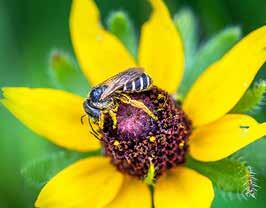
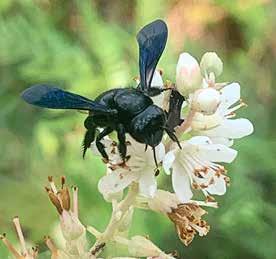
portunistic when it comes to finding a home: these bees have been known to build in mailboxes, house siding and just about anywhere else they can fit. While this can be annoying for humans, it is important that we remember these little bees play an important role in pollinating our native plants.
Bees are insects. What other creature is an insect?
Snail Butterfly Worm
Another bee found in Eastern North Carolina is Poey’s Furrow Bee (Halictus poeyi). These bees are amongst the most common bee in the Eastern United States. Though they are small, they are abundant!
Poey’s Furrow Bee is a type of sweat bee. Sweat bees got their name because they have short tongues that make it easy for them to lick up human sweat. For the most part, these bees are harmless to humans. Typically, the only time a person gets stung by a sweat bee is if the person squishes the bee. In fact, among all stinging insects, sweat bees have one of the least painful stings.
Although these bees do enjoy human sweat, their main food source is the pollen they get from native plants growing in the area. Even though they are very small, they play a large part in helping our ecosystem stay vibrant and healthy.
Wasps and Hornets are bees.
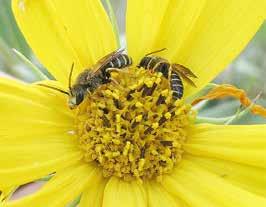
Bee populations have been declining over the years, and while we hear a lot about honey bees, it’s important to remember our native bees as well. Planting native flowers in your yard or porch flowerpot help provide food sources for these insects.
Carpenter-mimic Leafcutter bee at Halyburton Park. © Jessica M. Stitt, https://www.inaturalist.org/observations/88160346. Change made: Cropped with permission.
True or False?—False: Bees are vegetarians while wasps and hornets are carnivores.
Circle the Answer—Butterfly.
Plan ahead for Earth Day: The 2022 Faith Climate Action Week printed organizer’s kit is now available! The resources in this kit will equip you to lead faith-based discussion and action at your congregation to safeguard a thriving Earth for future generations.
Faith Climate Action Week is Interfaith Power & Light’s annual program of climatethemed worship services and sermons that spans ten days of activities around Earth Day, with this year’s dates being April 22— May 1, 2022. Join the community of people of faith preaching, teaching and acting to heal the climate in 2022!
The theme of 2022’s Faith Climate Action Week is “Sacred Trust: Our children’s right to a livable future.” We will examine our responsibility to safeguard our Earth for future generations, and how our faiths call us to respond with bold and just solutions to climate change.
A printed version of the organizer’s kit is available on the Faith Climate Action Week website for $24.
The value-packed kit includes a Sacred Trust guide with information on intergenerational climate justice and the moral and legal rights of our children and grandchildren to a livable climate. There are also suggestions and resources for how to get engaged in supporting local climate justice action, and a call for art created by youth and children that envisions a positive future for our Earth through the #ImagineIPL campaign. Additionally, you will find faith-based discussion materials, suggested short films and a Youth and Children Blessing ceremony.
Faith Climate Action Week 2022 offerings also include resources for sermons, talks, worship services, a film screening kit for the featured film, Youth v. Gov, and more.
Youth v. Gov is a powerful film that follows 21 young Americans suing the world’s most powerful government to protect their constitutional rights to a stable climate. The DVD, available in March, includes screening rights and a screening kit. See the calendar at www.youthvgov.
com to find virtual or in-person screenings in your area.
Visit www.faithclimateactionweek.org to learn more or to purchase your printed 2022 Faith Climate Action Week kit. The kit will be available for free download in March, and the site includes links to previous years’ kits and films. (The documentary Kiss the Ground was the 2021 film.) Organizer’s kits are evergreen and can be used any time of the year.
Interfaith Power & Light (IPL) is a national organization whose mission is to inspire and mobilize people of faith and conscience to take bold and just action on climate change. Their website, InterfaithPowerandLight.org, will list Faith Climate Action Week activities for individual states. North Carolina activities will be posted on www.faithclimateactionweek. org/north-carolina-listings/.
There are now IPL affiliates in 40 states. In 2005, NC Interfaith Power & Light became the 16th state affiliate. Learn more at https://ncipl.org.